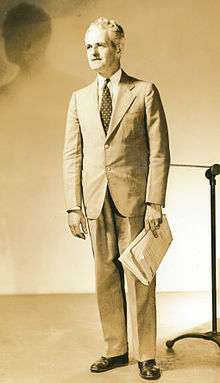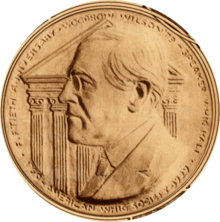Vincent Schofield Wickham
| Vincent Schofield Wickham | |
|---|---|
 | |
| Born |
September 29, 1894 Worcester, MA |
| Died |
December 9, 1968 New London, NH |
| Occupation | Editorial artist, sculptor |
Vincent Schofield Wickham (1894-1968) was a New York graphic illustrator, painter, sculptor, teacher, and inventor, whose career coincided with the Golden Age of American Illustration.[1] Wickham worked as an editorial artist for the New York Times from 1924-1956. His work included sports illustrations, window displays in Times Square, and promotional posters that were displayed on newspaper trucks. In addition to his job at NYT, he also taught advertising art and layout at Textile Evening High School (now the Bayard Rustin Educational Complex), on 351 West 18th Street.[1]



Early career
In 1917, Wickham received a degree in Modeling and Sculpture from Massachusetts Normal Art School,[2] (now Massachusetts College of Art and Design).[1] The same year, he apprenticed under renowned sculptor, and fellow Worcester native, Andrew O'Connor (sculptor). Being the "slimmest of the students," Wickham was O'Connor's model for the Spanish War Memorial statue, 1898 Soldier (image), still on display in Worcester's Wheaton Square.[3] Before his career as an editorial artist, Wickham invented orthodontal devices, including a "trimmer for bad teeth," and an "Appartus for Trimming Ondontological Casts," for which he received a US patent (Mar. 21, 1919).[4][5]
Sculptor
As a sculptor, Wickham was sought out and commissioned for projects. He struck the die for plaster casts commemorating the 160th anniversary of the American Whig Society, and the 50th anniversary of the graduation of Woodrow Wilson from Princeton University. These casts were unveiled at the Whig-Wilson Anniversary Celebration at Princeton American Whig–Cliosophic Society on December 11, 1929.[6] In 1929, Wickham was commissioned by the American Geographical Society for medallion Medals commemorating aviator and Antarctic explorer Rear Admiral Richard E. Byrd. Six years later, in 1935, Wickham sent the original model of this medallion to President Franklin D. Roosevelt.
Inspired by words as well as images, Wickham's poem, "A Bookplate Speaks," originally published in the New York Times, anthropomorphizes steel engraving printmaking, and showcases the artist's facility with language:
- Although begot of polished, graven steel,
- Entombed within thy lines do I conceal
- A soul; 'twere better were I ruby red,
- Perhaps, instead of black, so dead,
- For then, his every heartbeat I might feel
- And breathe and speak and tell the ardent zeal
- With which he studied, mastered every line
- Embodied in my quaint, beloved design.
- Thus now you well might look and long review
- Your bookplate; for the master's hand that drew
- This something which is me, for you to hold
- He, too, regarded me far more than gold
- Search long and well for him whose spirit lies
- Within my lines, in raven black disguise.[7]
Personal life
Wickham was married twice, first to Dorothy Callan (1908-1948; widowed), with whom he fathered two children, Vincent Jr. (1938-2000), Sally (1943—); and Vivian Mallett Roberge (1900-1984). A man of adventure, Wickham and his first wife, Dorothy Callan, took excursions by steamship to Peru, Cuba, and Bermuda. They also were members of the Old White Art Colony at Sulphur Springs, West Virginia, where they attended a charity dinner dance on August 23, 1939.[8] A lifelong learner, Wickham earned a Bachelor of Arts from the Commonwealth of Massachusetts, Department of Education, in 1957, at age 63.[1] Retiring to New London, New Hampshire, Wickham studied and wrote poetry, and continued teaching art. His reputation preceded him, and even in retirement he was commissioned to design emblems, including the New London Town Seal.

References
- 1 2 3 4 "Vincent Wickham, Retired Artist, 74". New York Times. December 10, 1968.
- ↑ Graduation Exercises of the Massachusetts Normal Art School, 1917
- ↑ Soderman, Doris Flodin (1995). The Sculptors O'Connor. Worcester, MA: Gundi Press. p. 69. ISBN 0-9642863-0-0.
- ↑ "Invents "Trimmer" for Bad Teeth". Boston Herald. 1924.
- ↑ Official Gazette of the United States Patent Office. United States, Patent Office. Retrieved 19 July 2013.
- ↑ "Whig Anniversary Guests to Receive Memorial Plaques". Daily Princetonian. December 10, 1929. Retrieved 19 July 2013.
- ↑ "A Bookplate Speaks". The Free-Lance Star. January 31, 1940.
- ↑ "Charity Fete Held at White Sulphur". The New York Times. August 23, 1939.